Stewart J. College Algebra: Concepts and Contexts
Подождите немного. Документ загружается.

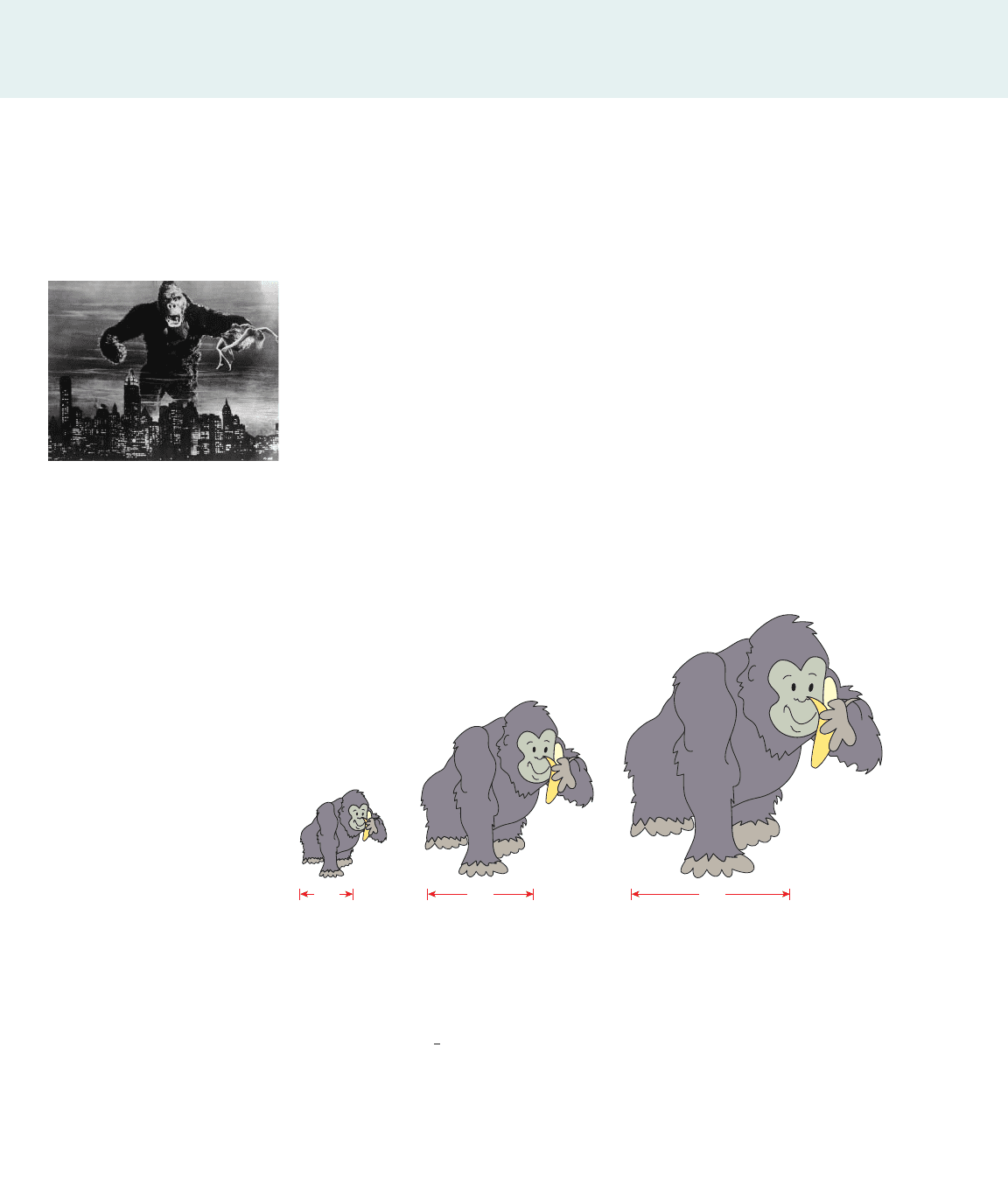
The scaling factor of two similar figures is the ratio of the distance between cor-
responding points. So the scaling factor between Gorillas C and A is 3. This means
that if two points are a distance x apart in Gorilla A, then the corresponding points
are a distance 3x apart in Gorilla C. (We can also say that the scaling factor between
gorillas A and C is .)
1. Find the following scaling factors:
(a) The scaling factor between Gorillas B and A is _______.
(b) The scaling factor between Gorillas A and B is _______.
(c) The scaling factor between Gorillas B and C is _______.
1
3
Only in the Movies?
OBJECTIVE To explore how power functions model relationships between shape
and size.
King Kong is “similar” to a normal 8-foot ape but a lot bigger. In fact, he’s just a
blown up version of the real thing. So how does King Kong’s shirt size or weight
compare to that of a normal gorilla? In this exploration we investigate how areas and
volumes of similar figures change as the size of the figure increases (or decreases).
We’ll find power functions that relate these quantities and use those functions to ex-
plore the possiblity of the existence of a real-life giant ape. We begin by finding some
properties of similar figures.
I. Similar Objects
Two objects are similar if they have the same shape even though they may not be the
same size. In geometry you learned that corresponding sides of similar triangles are
proportional. This last property holds for any two similar figures, not just triangles.
For example, the gorillas in the figures below are all similar. Gorilla C is three times
as tall as Gorilla A, so Gorilla C’s hand is three times as long, his eyes are three times
as far apart, his feet are three times as long, and so on. The figures “look the same”
precisely because they are similar in the mathematical sense.
1
King Kong is similar to a normal
8-foot ape but much bigger.
1 ft 2 ft 3 ft
AB C
554 CHAPTER 6
554 CHAPTER 6
■
Power, Polynomial, and Rational Functions
EXPLORATIONS
■
EXPLORATIONS
■
EXPLORATIONS
■
EXPLORATIONS
Hulton Archive/Getty Images
© Maria Bell/Fotolia
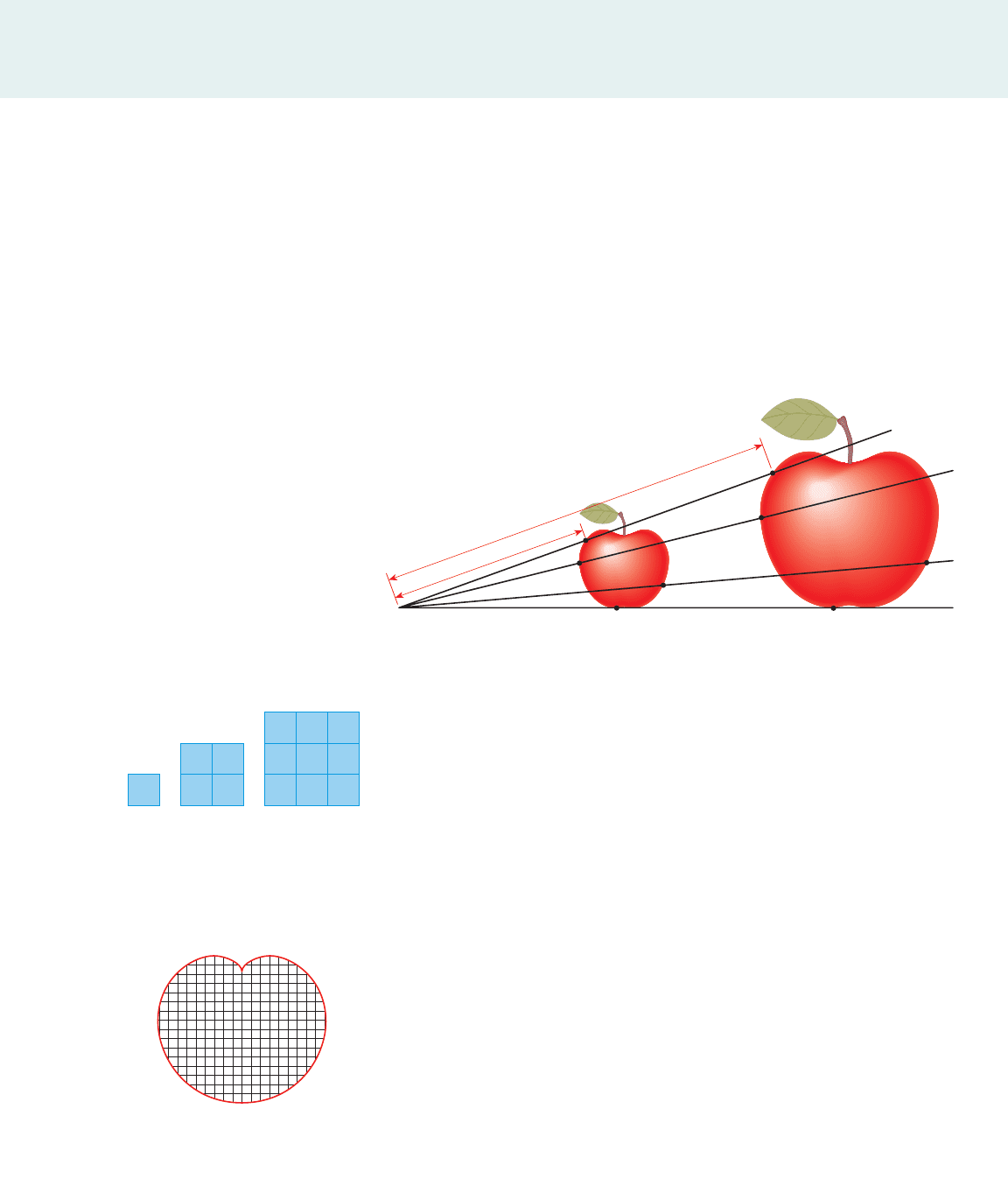
EXPLORATIONS
■
EXPLORATIONS
■
EXPLORATIONS
■
EXPLORATIONS
EXPLORATIONS 555
2. Is a map of Chicago similar to the city of Chicago? How are distances on the
map related to actual distances in the city? Is the scaling factor indicated on
the map?
3. How is your photograph similar to you? Compare distances between your
eyes, ears, length of nose, and so on to the corresponding distances in the
photograph. What is the scaling factor?
4. The figure illustrates a method of drawing an apple twice the size of a given
apple. Use the method to draw an apple one-third the size of the bigger apple
shown here.
II. Areas of Similar Objects
If two objects are similar, then how are their areas related? First, let’s see what hap-
pens if the objects are squares.
1. Look at the squares in the margin to help answer the following questions.
(a) If the side of a square is doubled, then its area is multiplied by _______.
(b) If the side of a square is tripled, then its area is multiplied by _______
(c) If the side of a square is multiplied by s, then its area is multiplied by
_______.
(d) Let’s prove the conclusion you made in part (c) algebraically.
■
If a square has side x, then its area is _______.
■
If a square has side sx, then its area is _______.
■
Conclude that for any two squares with scaling factor s, their areas
satisfy .
2. A plane figure can always be approximated by small squares (as shown in the
margin). Use what you learned about areas of squares in Question 1 to explain
why the following statement is true: For any two plane figures with scaling
factor s, their areas satisfy .
3. Any surface, whether flat or not, can be approximated by squares, so the
statement in Question 2 is true for any surface. Experiment with the surface
areas of cubes and spheres as follows. (Use the cubes shown in Part III on the
next page to help visualize the answer to part (a).)
A
2
= s
2
A
1
A
2
= s
2
A
1
A
2
=
A
1
=
a
2a

556 CHAPTER 6
■
Power, Polynomial, and Rational Functions
(a) If the side of a cube is doubled, then the surface area of the cube is multi-
plied by _______.
(b) If the radius of a ball is doubled, then the surface area of the ball is multi-
plied by _______.
4. Suppose an irregularly shaped object (such as a gorilla) has surface area A. If
the object is magnified 10 times (scaling factor 10), then the surface area of
the magnified figure is _______.
III. Volumes of Similar Objects
If two objects are similar, then how are their volumes related? First, let’s see what
happens if the objects are cubes.
EXPLORATIONS
■
EXPLORATIONS
■
EXPLORATIONS
■
EXPLORATIONS
556 CHAPTER 6
1. Look at the cubes above to help answer the following questions.
(a) If the side of a cube is doubled, then its volume is multiplied by _______.
(b) If the side of a cube is tripled, then its volume is multiplied by _______.
(c) If the side of a cube is multiplied by s, then its volume is multiplied by
_______.
(d) Let’s prove the conclusion you made in part (c) algebraically.
■
If a cube has side x, then its volume is _______.
■
If a cube has side sx, then its volume is _______.
■
Conclude that for any two cubes with scaling factor s, their volumes
satisfy .
2. A solid figure can be “filled” with little cubes. Use what you learned about
volumes of cubes in Question 1 to explain why the following statement is true:
For any two solid objects with scaling factor s, their volumes satisfy .
3. Suppose an apple has volume . If the apple is magnified 10 times (scaling
factor 10), then the volume of the big apple is _______.
IV. Real-Life Giant Apes?
1. Let’s suppose that King Kong is 10 times as tall as Joe, a normal-sized gorilla.
Of course, the two gorillas are similar.
(a) The scaling factor between King Kong and Joe is _______.
(b) If Joe’s foot is 20 inches long, then King Kong’s foot is _______ inches
long.
V
V
2
= s
3
V
1
V
2
= s
3
V
1
V
2
=
V
1
=

EXPLORATIONS
■
EXPLORATIONS
■
EXPLORATIONS
■
EXPLORATIONS
EXPLORATIONS 557
(c) If it takes 5 square yards of material to make a shirt for Joe, then it takes
_______ square yards of material to make a shirt for King Kong.
(d) If Joe weighs 500 pounds, then King Kong weighs _______ pounds.
2. Your answer to Question 1(d) indicates that King Kong weighs half a million
pounds. If he is made of normal flesh and blood, would his bones be able to
support his weight? Or would his bones be crushed under his weight? In fact,
no known substance is strong enough to withstand such enormous weight, so a
living, moving gorilla of this size doesn’t seem possible.
Proportionality: Shape and Size
OBJECTIVE To investigate real-world situations using the proportionality symbol r.
In this exploration we investigate the proportionality symbol r. We examine how
this notation is used in several real-world situations. In one such situation we deter-
mine how a frog’s size relates to its sensitivity to pollutants in the enviroment.
The health of frogs is a key indicator of how an ecosystem is faring. Frogs live
on land and in the water, and they breathe and drink through their skin. So they are
particularly sensitive to changes in any aspect of the environment; they are often
the first species affected by pollutants or toxins in the land, water, or air. Of course,
the effect of a toxin on a frog is proportional to the concentration of the toxin in its
body. We use the proportionality symbol to discover the relationship between a
frog’s ability to absorb toxins (the surface area of its skin) and its weight (or its
volume).
I. The Proportionality Symbol
A formula for the area of a square is , and a formula for the area of a circle is
. In each case the area is proportional to the square of a “length” measure-
ment (see Section 6.2). It would be difficult to find formulas for the areas of irregu-
lar shapes. But for all objects of the same shape, the area A is proportional to the
square of the length L. That is, there is a constant k such that . We express
this proportionality by writing
The symbol means “is proportional to.” Similarly, the volume of an object is
proportional to the cube of its length L:
In each case the constant of proportionality depends on the shape of the object and
the particular “length” we are measuring.
1. The “size” of a TV is given by the length L of the diagonal of the screen. But
the cost of manufacturing a TV is largely determined by the area of the
screen, not by the length of the diagonal. The figure shows a 20-inch TV and a
V r L
3
Vr
A r L
2
A = kL
2
A = pr
2
A = x
2
2
The health of frogs is an indicator
of the health of an ecosystem.
Luis Louro/Shutterstock.com 2009
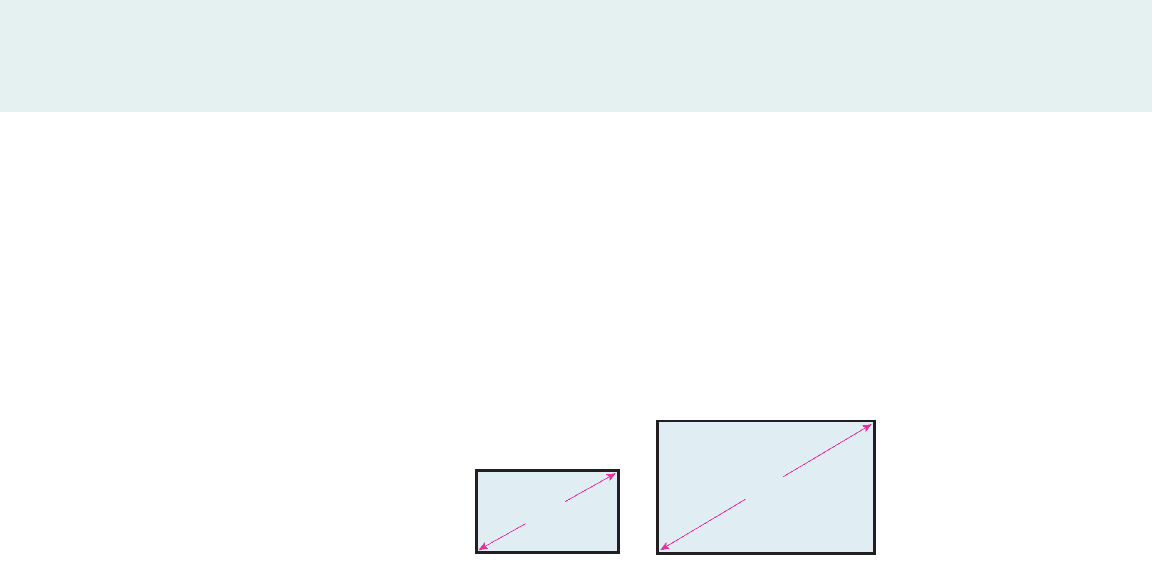
20 in.
30 in.
20-inch TV 30-inch TV
EXPLORATIONS
■
EXPLORATIONS
■
EXPLORATIONS
■
EXPLORATIONS
558 CHAPTER 6
30-inch TV. Use the proportionality relation to answer the following
questions:
(a) The ratio of the diagonals of the TVs is _______, so the ratio of the areas
of the TVs is _________________
(b) If a 20-inch TV costs $240, how much would we expect a 30-inch TV to
cost?
______________________________________________________.
A r L
2
2. The “size” of a sailboat is given by its length. The cost of manufacturing a
sailboat is determined by its volume, not by its length. Consider a 20-foot boat
and a 40-foot boat. Use the relationship to answer the following
questions:
(a) The ratio of the lengths of the two boats is _______, so the ratio of their
volumes is _________________.
(b) If a 20-foot boat costs $10,000, what would you expect a similar 40-foot
boat to cost?
______________________________________________________
II. Proportionality: Surface Area and Volume
How much more material is needed to manufacture an industrial plastic container
with twice the volume of a similar container? To answer this question, we need to
find the relationship between volume and surface area. In general, we know that
We can write these proportionalities as
Since each of these quantities is proportional to L, they must be proportional to each
other. That is, . Squaring both sides we conclude that
Use this proportionality to answer the following questions.
1. A manufacturer of plastic containers prices its product by the amount of
plastic used to make the container (surface area). A particular container costs
$12. How much would you expect a container with eight times the volume to
cost?
A r V
2>3
A
1>2
r V
1>3
A
1>2
r LandV
1>3
r L
A r L
2
andV r L
3
V r L
3
30/20
(30/20)
2
= 2.25
We would expect it to cost 2.25 x 240 = $540

EXPLORATIONS
■
EXPLORATIONS
■
EXPLORATIONS
■
EXPLORATIONS
EXPLORATIONS 559
2. The price of a child’s swimming pool depends on the amount of plastic used
to manufacture it. A 50-gallon pool costs $35. How much would you expect a
100-gallon pool to cost?
3. If we have a granite cube, how much pressure does the cube exert on its base?
To calculate pressure, we divide the weight of the cube by the area of the base:
So the pressure on the base of a 12-inch cube of granite that weighs 180 pounds is
/in
2
Notice that pressure is weight per unit area. From the figure in the margin we
can see that the weight exerted on each square inch of the base is simply the
weight of the column of granite that is directly above that square inch. So the
pressure should be proportional to the side length of the cube, that is, .
Let’s arrive at this same result using proportionality.
(a) From the above discussion we have
Using the fact that and , we can rewrite the expression for
P as
It follows that .
(b) If the side of a granite cube is 10 times that of another granite cube, the
pressure exerted by the larger cube on its base is _______ times the
pressure exerted by the smaller cube on its base.
III. Proportionality in the Natural World
The natural world presents us with numerous creatures of greatly varying shapes and
sizes, each perfectly adapted to its environment. These creatures must live by the
same rules of geometry and the same relationships between length, area, and volume
as we do. Let’s explore some of these using the proportionalities
1. For animals with roughly the same shape, we would expect the length and
volume (or weight) to satisfy the proportionality .
(a) Look up average heights and weights for sheep and cows. Do your findings
conform to the expected proportions? Make sure you use the same length
measurements for each animal (from ground to shoulder, head to rump, etc.).
(b) Repeat part (a) for other animals.
V r L
3
A r L
2
V r L
3
A r V
2>3
P r
V
A
P r L
P r
ⵧ
ⵧ
A r L
2
V r L
3
P r
V
A
P r L
pressure =
180
12
2
L 1.25 lb
pressure =
weight
area of base
L
R
R

2. Frogs absorb nutrients through their skin, so they are very susceptible to
toxins in the environment. The amount of toxins a frog absorbs in this way is
proportional to the surface area of its skin, but the effects of the toxins on a
frog are proportional to the concentration of the toxin in the frog’s body.
Suppose the volumes of Frogs F and G are and respectively.
(a) The ratio of the volumes of the frogs is _______, so the ratio of their
surface areas is _______. (Use the fact that .)
(b) If Frog F absorbs 0.015 mL of a certain toxin, we would expect Frog G to
absorb _______ mL.
(c) The concentration of a toxin is the amount of the toxin divided by the
volume of the frog. So
Concentration in Frog F is _______
Concentration in Frog G is _______
(d) Are toxins in the environment more harmful to smaller frogs or larger
frogs?
3. Let’s consider the possibility of real-life giant apes. Let’s assume that Big
Foot is an ape that is 10 times as tall as an ordinary ape.
(a) Complete the following about Big Foot:
Height is _______ times that of an ordinary ape.
Weight is _______ times that of an ordinary ape.
Surface area is _______ times that of an ordinary ape.
Pressure on feet is _______ times that of an ordinary ape.
(b) Assuming that Big Foot’s bones are made of the same material as those of
the ordinary ape, do you think his bones can support his weight? Why or
why not?
A r V
2>3
40 cm
3
5 cm
3
EXPLORATIONS
■
EXPLORATIONS
■
EXPLORATIONS
■
EXPLORATIONS
560 CHAPTER 6
LuckyKeeper\Shutterstock.com 2009
10
Managing Traffic
OBJECTIVE To use rational functions and proportionality to analyze the problem of
road capacity.
The best way to keep traffic moving is to avoid accidents, and the best way to avoid
accidents is for drivers to maintain a safe following distance. To give drivers enough
time to react to unforeseen events, the safe following distance is greater at higher
speeds. You may be familiar with the car-length rule (at least one car length for every
10 miles per hour) or the 2-second rule (the car ahead must pass some object at least
2 seconds before you do). In this exploration we investigate how algebra can help us
find how many cars a road can carry at different speeds—assuming, of course, that
all drivers maintain a safe following distance.
3
How many cars can a road safely
carry at different speeds?
silver-john/Shutterstock.com 2009
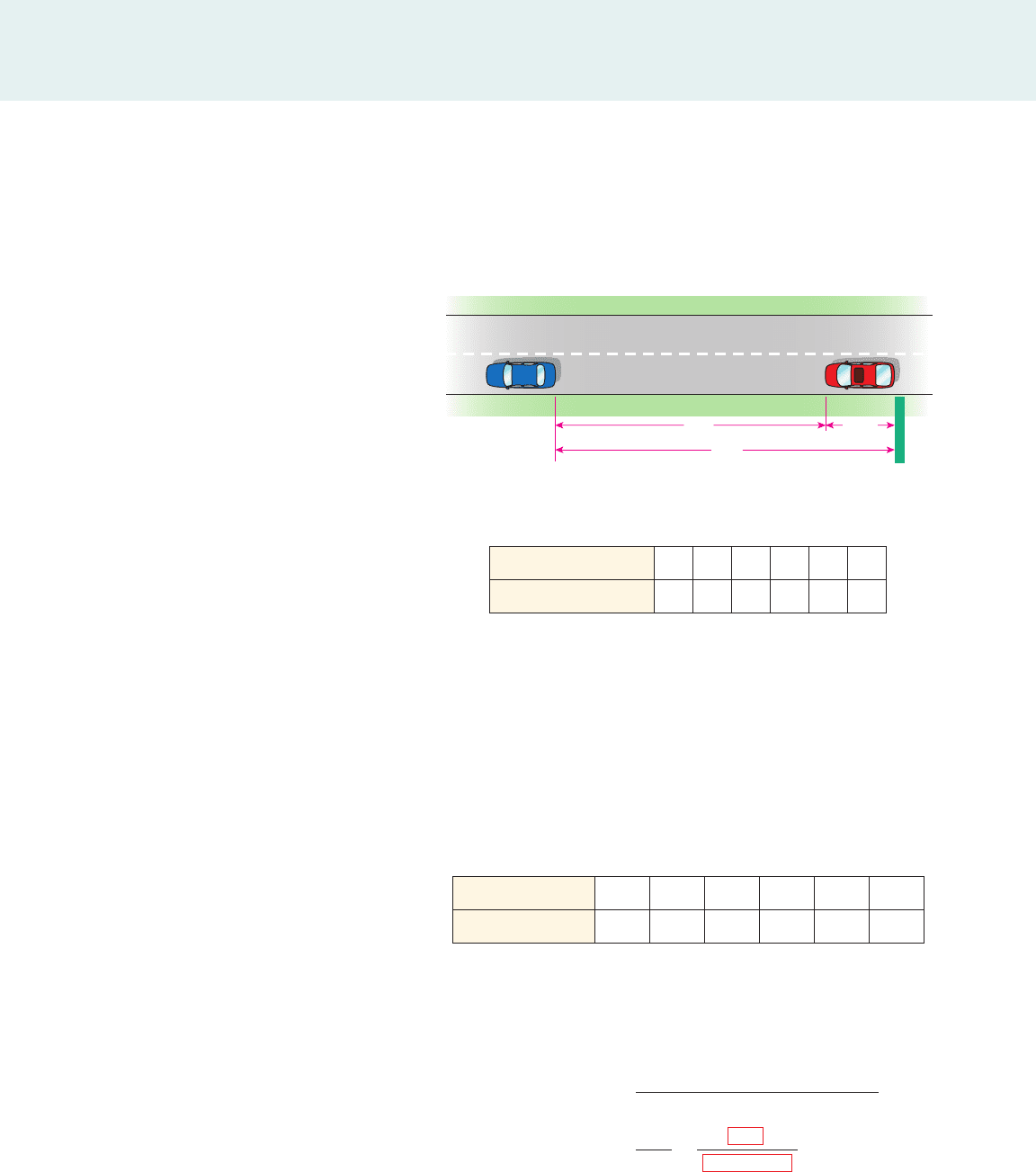
EXPLORATIONS
■
EXPLORATIONS
■
EXPLORATIONS
■
EXPLORATIONS
EXPLORATIONS 561
I. Carrying Capacity and Safe Following Distance
We’ll investigate how many cars a road can safely carry at different speeds. Let’s as-
sume that each car is 20 feet long and that the safe following distance is one
car length for every 10 miles per hour of the speed s.
The following diagram is helpful in visualizing traffic.
F1s 2
1. Let’s find a formula for the safe following distance at any speed.
(a) Complete the table for the safe following distance.
F(s) 20 ft
D(s)
Speed s 10 20 30 40 50 60
Following distance F
20
(b) So at a speed of s miles per hour, the safe following distance is
_______.
(c) At a speed of s miles per hour the road distance that each car uses is
2. Since we are measuring car lengths in feet, let’s convert speeds from the
familiar miles per hour to feet per minute.
(a) Use the fact that /h /min to complete the table.= 88 ft1 mi
= ______ + ______
D1s 2= length of car + safe following distance
D1s 2
F1s 2=
(b) From the pattern in the table we see that s mi/h is the same as
_______ ft/min.
3. If traffic is moving at s miles per hour, then the number of cars that pass
a given point every minute is given by
We’ll call the number the carrying capacity of the road at speed s.N1s 2
=
=
V1s 2
D1s 2
N1s 2=
distance cars travel in one minute
distance each car uses
N1s 2
V1s 2=
Speed (mi/h) 10 20 30 40 50 60
Speed (ft/min)
880
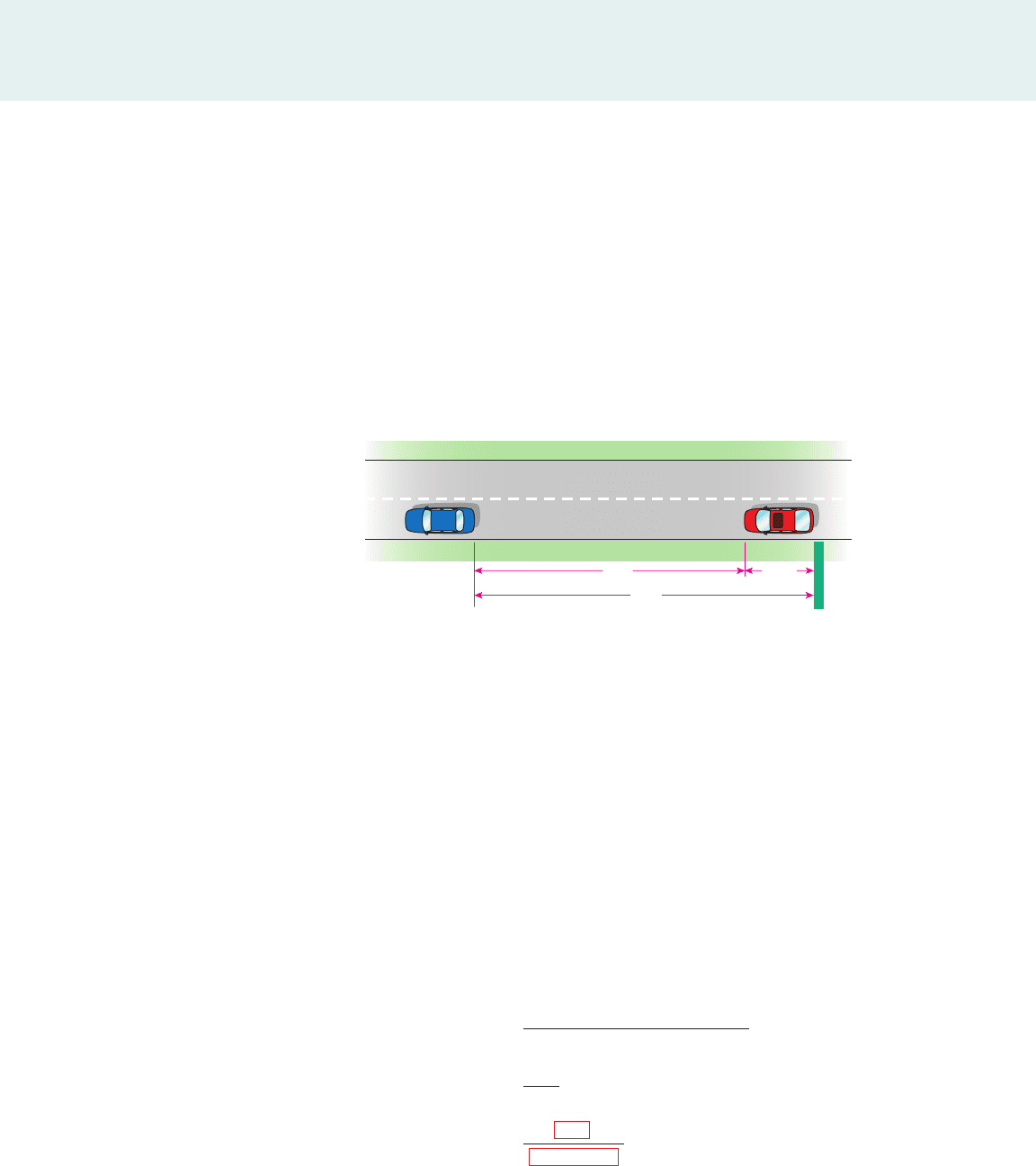
EXPLORATIONS
■
EXPLORATIONS
■
EXPLORATIONS
■
EXPLORATIONS
562 CHAPTER 6
4. Graph the rational function you found in Question 3.
(a) What happens to the carrying capacity of the road as the speed increases?
(b) At what speed is the carrying capacity greatest?
II. Using Braking Distance to Find Maximum Carrying Capacity
For a moving car the braking distance is the distance required to bring the car to a
complete stop after the brakes are applied. We can infer from physical principles that
the braking distance is proportional to the square of the speed s.
Using the braking distance as the safe following distance, let’s try to find the
speed at which the maximum carrying capacity occurs. The following diagram is
helpful.
T 1s2
Note that the stopping distance, the
actual distance required to stop a
car, is greater than the braking
distance because of the reaction
time needed before the brakes are
applied.
T(s) 20 ft
D(s)
1. Let’s find a formula for the braking distance at speed s.
(a) Express the above proportionality statement as an equation:
_______
(b) Suppose that the braking distance at 20 mi/h is 20 ft. Use this fact to find
the proportionality constant. So the braking distance is given by the
formula
_______
(c) Let’s assume that each car maintains the proper braking distance from the
next car. In this case, at speed s the road distance each car uses is
2. If traffic is moving at s miles per hour, then in this case the carrying capacity
of the road is
=
=
V1s 2
D1s 2
N1s 2=
distance cars travel in 1 minute
distance each car uses
N1s 2
= _____ + _____
D1s 2= length of car + braking distance
D1s 2
T 1s2=
T 1s2=
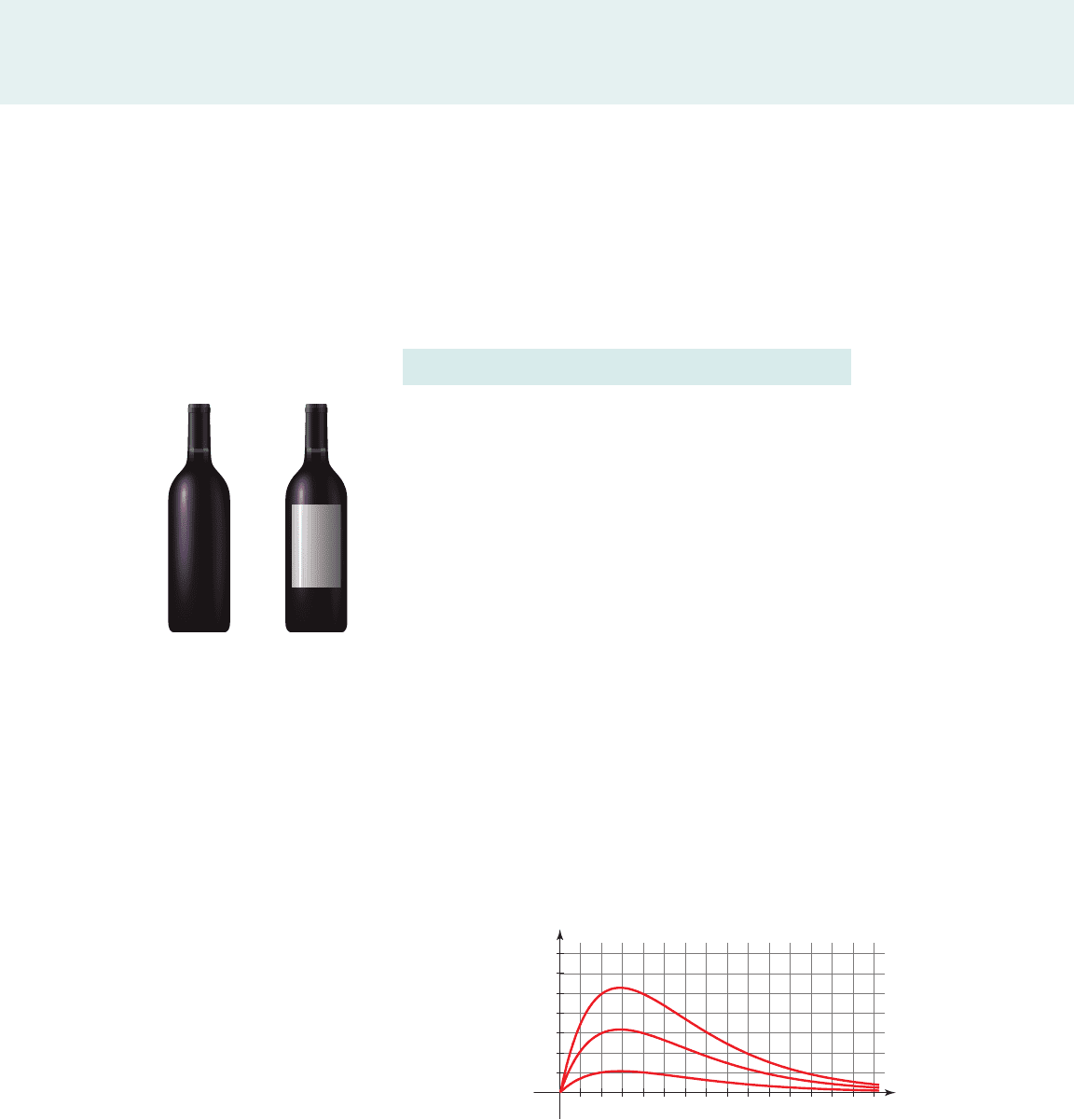
EXPLORATIONS
■
EXPLORATIONS
■
EXPLORATIONS
■
EXPLORATIONS
EXPLORATIONS 563
3. Graph the rational function you found in Question 2.
(a) What happens to the carrying capacity as the speed increases?
(b) What is maximum carrying capacity? At what speed (in mi/h) does it occur?
4
Alcohol and the Surge Function
OBJECTIVE To model data on blood alcohol concentration using surge functions.
In the Prologue to this book (page P2) we introduced the problem of modeling the blood
alcohol concentration following the consumption of different amounts of alcohol. We
are now ready to experiment with finding an appropriate function to model the data.
We can see from the data that there is an initial rapid surge in the blood alcohol
concentration followed by a decay as the body eliminates the alcohol. To model this
behavior, we need a function that combines an increasing factor with a decaying one.
Such functions are called surge functions and have the form
We need to experiment with these functions to find appropriate values of a and b that
model our data.
I. Experimenting with the Surge Function: Varying a
We first find out how changing the value of a affects the graph of a surge function.
1. Let’s pick a particular value for b, say 0.7, and experiment with changing the
value of a.
(a) Graphs of the following surge functions are shown:
Match each function with its graph.
S
1
1t2= t
#
10.72
t
S
2
1t 2= 3t
#
10.7 2
t
S
3
1t 2= 5t
#
10.7 2
t
S1t 2= at
#
b
t
Martin Spurny/Shutterstock.com 2009
S(t)
t
0
123456789101112131415
1
2
3
4
5
6
7
(b) Use a graphing calculator to graph the surge functions for
the following values of a: 2, 4, 6. Sketch the graphs you obtain on the
graph in part (a).
S1t 2= at
#
10.72
t
